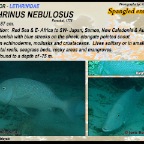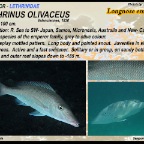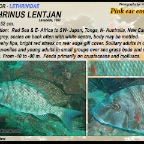Emperors - Lethrinidae
EMPERORS - LETHRINIDAE
There are around twenty different species of emperorfish in the sea, although most live in tropical waters. This relatively unknown fish has a silvery-grey body, with a pale color pattern. This makes it difficult to determine them underwater. Some species have a short snout and thick lips while others can have long pointy beaks. They are mainly active at night and spend their days hiding underneath coral tables or other hiding spots. Many of the emperorfish are able to change tone or color very quickly depending on the substrate or the mood they are in. These color changes are mostly observed late in the afternoon when mating starts. However not much is known about their reproduction. Most species live among sandy areas close to coral reefs where they feed on bottom-dwelling invertebrates like snails, crustaceans and bristle worms. Some of the bigger species feed on fish. All young emperorfish grow up as females and can change sex over time. Length: 60 cm.Distribution: Red Sea to S.W- Japan, Hawaii, Fr. Polynesia and New Caledonia.Juveniles have four white vertical stripes on body and yellow tail fin. Adults silvery with yellow area on head, becomes yellowish-pink with age. Filters sand during night time to feed on hard-shelled invertebrates. Adults solitary or in aggregations on reef slopes in lagoons and sea-ward reefs with sand patches, from -1 to -100 m.
Length: 50 cm.Distribution:E- Africa, SW- Japan, Micronesia, Marquesan Is, New Caledonia, Australia. Olive-grey to red-brown with diffuse stripes and bars on body. Pale margin on anal and pelvic fins, and reddish snout. Solitary or in small groups, above sand and rubbleareas of coastal and outer reef slopes, from -12 to -40 m. Length: 100 cm.Distribution: R. Sea to SW- Japan, Samoa, Micronesia, Australia and New- Caledonia. Largest species of the emperor family, grey to olive colour. Often display mottled pattern. Long body and pointed snout. Active and a fast swimmer. Solitary or in group, on sandy bottoms of lagoons and outer reef slopes down to -185 m. Length: 87 cm.Distribution: Red Sea & E- Africa to SW- Japan, Samoa, New Caledonia & Australia. Grey-greenish with blue streaks on the cheek, elongate pointed snout.Feeds on echinoderms, mollusks and crustaceans. Lives solitary or in small groups. On coastal reefs, seagrass beds, rocky areas and mangroves. Can be found to a depth of -75 m. Length: 52 cm.Distribution: Red Sea & E- Africa to SW- Japan, Tonga, N- Australia, New Caledonia.Silvery-grey, scales on back often with white centre, body may be mottled. Thick fleshy lips, bright red streak on rear edge gill cover. Solitary adults in deeper water, juveniles and young adults in small groups over sea grass beds and mangrove swamps. From -10 to -90 m. Feeds primarily on crustaceans and molluscs. Length: 50 cm.Distribution: from E- Africa to the Philippines, Indonesia, Solomon Is. and Caroline Is. Yellow-brown-ish with faint red bars and red fins. Bright red spot on the base of the pectoral fin. Two pale to bright white bars on tail base, red around the eyes and on the snouth.Solitary or in small groups on coastal reefs and lagoons, from -2 to -25 m. Length: 86 cm.Distribution: Red Sea & E- Africa to SW- Japan, Samoa, New Caledonia & Australia. Grey-greenish with blue streaks on the cheek, elongate pointed snout.Lives solitary or in small groups. Mostly seen above sandy bottoms close to reefs,seagrass or mangroves. Can be found to a depth of -75 m. Length: 35 cm.Distribution: Andaman Sea to S- Japan, Malaysian peninsula and Indonesia.Silvery with five to eight narrow dark bars on sides, and one through the eyes.Juveniles with a blotched pattern, as shown on the photographs. Feeds on bottom-living invertebrates. Solitary or in small groups, sand, mud and rubble slopes of coastal reefs, from -20 to -80 m.























